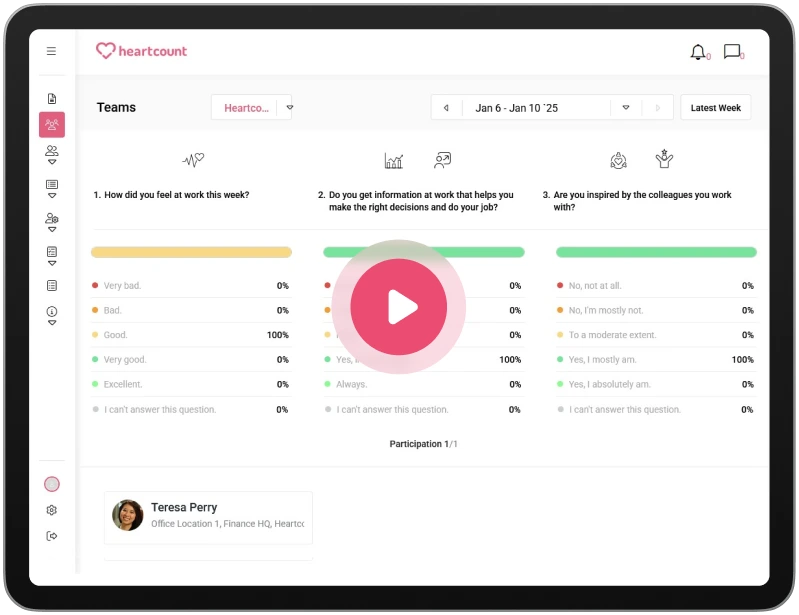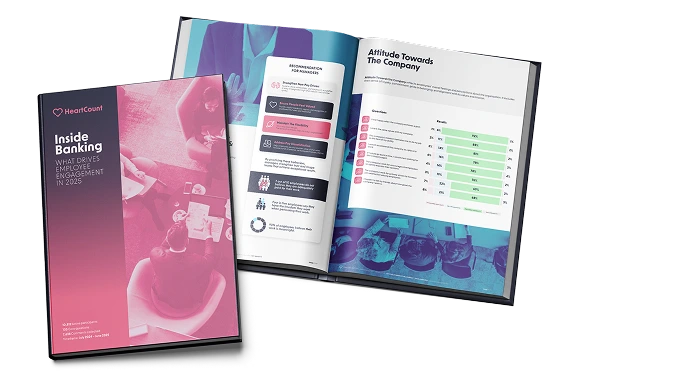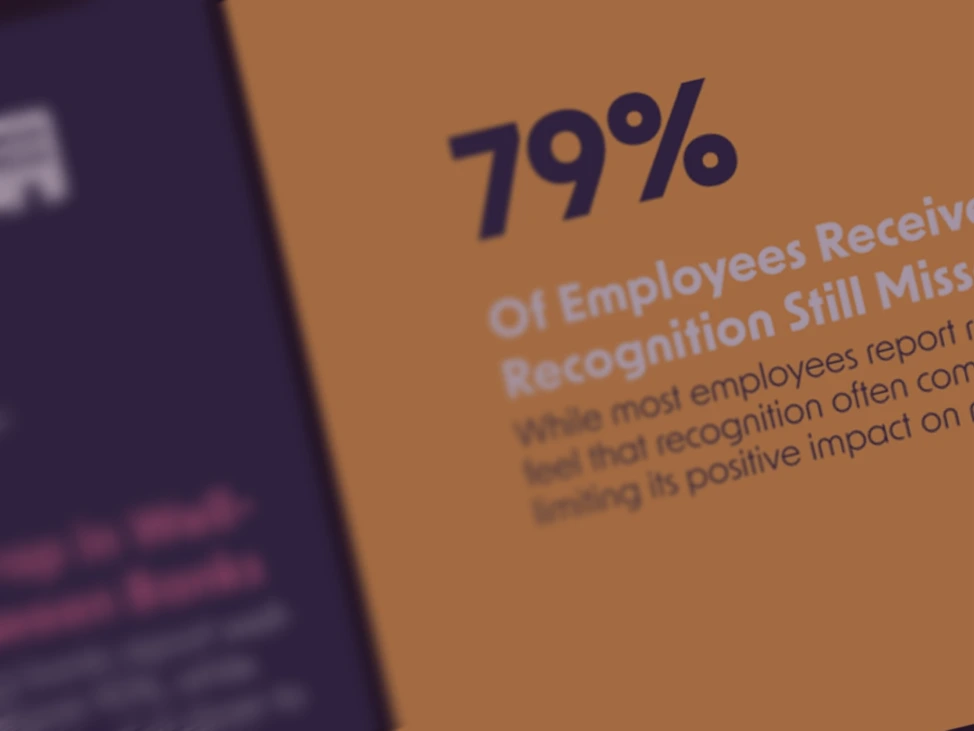How to Create an Effective Employee Engagement Survey Results Presentation

Employee engagement surveys are the mirror reflecting the heart of your organization. When you present the employee survey results effectively, you show your team that their voices matter. You also nurture a culture of transparency and trust.
Whether you’re sharing insights with employees, managers, or executives, the way you deliver those survey results is crucial. In fact, how you structure and deliver the survey results presentation can be just as important as the results themselves.
Presenting engagement survey results is your chance to build bridges, address concerns, and inspire collective progress. It’s an opportunity to turn raw data into a powerful story of growth and improvement that resonates across your organization.
Employee engagement surveys are the mirror reflecting the heart of your organization. When you present the employee survey results effectively, you show your team that their voices matter. You also nurture a culture of transparency and trust.
Whether you’re sharing insights with employees, managers, or executives, the way you deliver those survey results is crucial. In fact, how you structure and deliver the survey results presentation can be just as important as the results themselves.
Presenting engagement survey results is your chance to build bridges, address concerns, and inspire collective progress. It’s an opportunity to turn raw data into a powerful story of growth and improvement that resonates across your organization.
Why sharing survey results matters
Why should you share the results of an employee engagement survey? Because transparency builds trust. When you openly communicate the findings, you show your team that their feedback isn’t just heard. Rather, it’s being acted upon in the form of an employee engagement action plan. In fact, 90% of workers say they are more likely to stay at an employer that takes and acts on feedback.
Sharing serves as a strategic lever for improving your organizational culture. Research indicates that 82% of employees feel stronger connections and better relationships across teams and departments when engaged in mentoring programs.
By effectively communicating through a survey results presentation, you create a cycle where employees see their input leading to meaningful changes. This process builds long-term trust, strengthens employee morale, and establishes your organization as responsive and adaptable. It also lays the foundation for a workplace culture of accountability and mutual respect.
Think about it: what better way to create a sense of collective ownership than by involving everyone in your organization’s journey? Sharing goes beyond raw data. Instead, it creates an ongoing dialogue. Employees feel valued when they see their input driving decisions. Conversely, managers and executives gain insights to align their strategies with what truly matters to your team.
When you share the survey results thoughtfully, you position your organization as one that prioritizes listening and improvement. It’s a tangible way to demonstrate your commitment to measuring engagement and actively amplifying it. And when you do that, you’re not just managing your workforce—you’re inspiring them.
Tips for creating an engagement survey results presentation
Crafting an effective survey results presentation creates a connection with your audience and sparks meaningful change. Here are some actionable tips to ensure your presentation resonates:
- Thank employees for their participation
Start by acknowledging the effort employees put into completing the survey. A simple thank-you can go a long way in making them feel valued and more invested in the results.
- Build trust through transparency
Share both the good and the bad with openness. Employees appreciate honesty, and presenting all findings—including areas for improvement—signals your organization’s commitment to growth and accountability.
As Ian Hutchinson, author of People Glue, wisely says, “Your number one customers are your people. Look after employees first and then customers last.”
By prioritizing your employees’ feedback and well-being, you demonstrate that their voices matter and that you are committed to building a positive and supportive workplace culture.
- Focus on key findings
In your survey results presentation, highlight the most impactful insights, including both strengths and areas for improvement. Avoid overwhelming your audience with too much data; instead, zero in on trends that matter most to the organization’s goals.
- Spotlight trends over time
Show how this year’s employee survey results compare to previous surveys or industry benchmarks. Identifying trends over time or highlighting areas where your organization stands out gives context to the results and reinforces a commitment to continuous improvement.
- Highlight trends and benchmarks
Frame key insights in the context of your organization’s mission, values, or long-term goals. For example, link increased employee engagement scores to improved productivity or retention rates to align the results with broader strategic initiatives.
- Use storytelling
Data is powerful, but stories are memorable. Share real examples or quotes (anonymized if needed) from the survey that bring the data to life. This makes the findings relatable and engaging.
- Be honest about low scores
Address areas of low engagement openly and with empathy. Acknowledge the challenges while emphasizing the steps your organization will take to improve employee happiness. Transparency builds trust.
- Emphasize actionable steps
Your audience wants to know what comes next. Clearly outline the actions you’ll take in response to the survey findings and set realistic expectations for change.
- Encourage open dialogue
Develop a two-way conversation by inviting feedback and questions during or after the presentation. This reinforces your commitment to listening and improvement.
In fact, 89% of HR leaders agree that ongoing peer feedback and check-ins are key for improving employee engagement, highlighting the importance of continuous communication. Creating a feedback loop encourages transparency and further engagement.
- Create space for questions and feedback
Dedicate time for your audience to share thoughts, ask questions, or provide additional input. This can offer new perspectives and strengthen trust.
- Celebrate wins
Don’t just focus on challenges—celebrate the successes, no matter how small. Recognizing what’s working well reinforces positive behaviors and morale.
- Follow up on progress
Commit to ongoing updates. Regularly share progress on the actions you’ve promised so your audience knows their feedback is driving real change.
- Visualize the data
Use charts, graphs, or infographics to clarify your survey results presentation and display data clearly and effectively. Visuals help break down complex findings and make the information easier to digest.
- Tailor the presentation to your audience
Not every audience interprets data the same way. Customize the presentation for different groups—executives, managers, and employees. For example, focus on:
- high-level strategic impacts for executives,
- actionable steps for managers,
workplace transparency for employees.
How to tailor your presentation for maximum impact
Different groups within your organization have different priorities, so tailoring your presentation ensures relevance and impact. Here’s how to adjust your approach for key audiences:
For executives
- Focus on high-level metrics:
Highlight data points that directly connect to organizational goals, such as productivity, retention rates, or profitability.
- Show business impact:
Frame the insights in terms of ROI, risk mitigation, or strategic growth opportunities.
- Keep it concise:
Executives value brevity. Hence, stick to the key takeaways and actionable recommendations.
For managers
- Dive into team-specific data:
Share insights relevant to their teams and provide actionable recommendations they can implement directly, using a survey template for guidance.
- Link to management practices:
Discuss how findings relate to leadership styles, communication, and team dynamics, including the survey process.
- Encourage ownership:
Empower managers to take the lead in addressing team-specific issues and leveraging strengths.
For employees
- Be transparent:
Share the overall trends and explain how their feedback influenced the findings.
- Highlight the next steps:
Clearly outline how their input will shape organizational decisions and improvements.
- Promote inclusivity:
Use language that emphasizes collective progress and shared goals. Encourage employees to stay engaged by voicing ideas during the presentation or afterward.
Tailoring your presentation ensures that each group walks away feeling informed, valued, and inspired to contribute to positive change. When done right, these tailored messages can strengthen relationships and align everyone toward common goals.
Adjusting the presentation to different audiences
When it comes to presenting engagement survey results, one size doesn’t fit all. Each audience—executives, managers, and employees—has unique priorities and expectations. Tailoring your presentation to address these differences ensures the insights are relevant and actionable for everyone involved.
Different groups interpret data differently. A generic presentation risks losing the attention of your audience or failing to resonate with their specific needs. For instance, executives prioritize ROI and strategic alignment, while employees are more interested in how their feedback leads to tangible changes in their daily work experience.
By tailoring the presentation to address these unique perspectives, you ensure each audience feels valued and engaged, building alignment and collaboration across all levels of the organization.
For executives: high-level metrics and strategic insights
Executives need to see how the survey results tie into the organization’s broader goals and strategies. They are focused on big-picture outcomes and how engagement impacts business performance.
For example, if the survey reveals a direct correlation between high engagement scores and increased retention rates, frame it as a financial benefit: “Teams with 20% higher engagement saw a 30% reduction in turnover costs.”
This approach ties engagement metrics directly to ROI, which resonates with executive priorities. Benchmarking against competitors or industry standards can provide context, demonstrating how your organization measures up in nurturing engagement as a strategic advantage.
Moreover, companies with high employee engagement levels are 21% more profitable, underscoring the direct impact that engagement can have on business outcomes. Highlighting this connection makes a compelling case for why engagement and career development should be top priorities.
- Highlight business impact:
Present data that demonstrates how engagement influences key metrics such as productivity, profitability, retention, and customer satisfaction.
- Focus on trends:
Discuss long-term patterns and benchmark the current results against past surveys or industry standards to show progress or areas needing attention.
- Keep it brief:
Use a concise, results-driven format with clear visuals to emphasize the most critical insights.
- Offer strategic recommendations:
Frame findings in a way that aligns with organizational goals, such as reducing turnover, improving leadership effectiveness, or amplifying innovation.
For managers: Team-specific data and practical steps
Managers are on the front lines of employee engagement, making it vital to provide insights they can act on within their departments. If a team’s survey results show low scores in recognition, suggest a practical solution such as implementing peer-to-peer recognition tools or weekly shout-outs during team meetings.
For low communication scores, recommend specific actions like setting up monthly one-on-ones or creating team Slack channels dedicated to open dialogue. These targeted steps empower managers to address concerns directly and improve their team’s day-to-day work environment. And with 85% of employees not actively engaged or actively disengaged at work, the need for effective engagement strategies is more critical than ever.
- Zoom in on team data:
Share results specific to their teams, highlighting strengths and areas for improvement that directly impact their work environment.
- Provide actionable advice:
Equip managers with practical strategies and tools to address challenges and sustain strengths. For example, if low communication scores are a concern, suggest regular team check-ins or leadership training.
- Encourage ownership:
Empower managers to take the lead in implementing changes. Discuss how they can leverage engagement results to build better relationships and team performance.
- Align with their role:
Make connections between the data and their responsibilities, showing how addressing engagement will improve their team’s productivity and morale.
For employees: Transparency and collective progress
Employees want to know that their feedback is valued and will lead to meaningful change. For them, it’s about transparency, inclusivity, and action. Sharing survey findings, especially around challenges like disengagement or lack of fulfillment, can demonstrate your commitment to improvement. As Tina Kiefer, expert in organizational behavior, points out: “Burnout, toxic management, and a lack of meaningful work are the primary reasons UK workers are ‘quietly quitting.’”
By addressing these root causes with initiatives like flexible scheduling or improved leadership practices, organizations can show employees that their voices are catalysts for meaningful action. Transparency isn’t just about sharing results—it’s about showing employees that change is happening because of their input and survey feedback
- Share overall trends:
Focus on the organization-wide results, avoiding overly granular details. Highlight themes that reflect employee perceptions, employee input, and concerns.
- Explain the “why”:
Show how their feedback drives decisions and initiatives. Help them see the connection between their input and the changes that follow.
- Celebrate wins and address challenges:
Be open about strengths while acknowledging areas that need improvement. Frame challenges positively by emphasizing the steps you’ll take to resolve them.
- Invite engagement:
Encourage employees to share their thoughts, ask questions, or provide ideas during and after the presentation. Reinforce that this is a dialogue, not a one-sided report.
- Outline next steps:
Clearly communicate what actions the organization will take next and set expectations for future surveys, updates, and progress tracking.
By tailoring your presentation to the unique interests of each group, you create a meaningful experience that builds trust, promotes collaboration, and inspires everyone to contribute to the organization’s success.
Common mistakes to avoid when presenting survey results
Presenting engagement survey results is a powerful opportunity to strengthen your organization, but certain missteps can undermine the impact. Here are the most common mistakes and how to avoid them:
1. Overloading with data
- The mistake:
Bombarding your audience with excessive details and metrics.
- How to avoid:
Focus on the most relevant insights. Prioritize key themes, trends, and actionable findings over an exhaustive data dump.
2. Avoiding difficult topics
- The mistake:
Skipping over low engagement scores or negative feedback.
- How to avoid:
Acknowledge areas for improvement with honesty and empathy. Frame them as opportunities for growth and outline steps for addressing challenges.
3. Failing to connect insights to actions
- The mistake:
Presenting results without showing how they’ll lead to change.
- How to avoid:
Always pair findings with clear next steps. Explain how the organization will act on feedback and set expectations for follow-up.
4. Using complex or confusing visuals
- The mistake:
Overcomplicated charts or visuals that make data hard to understand.
- How to avoid:
Use clean, simple visuals like bar graphs, pie charts, or a dashboard of employee data. Label them clearly and focus on one idea per graphic.
5. Ignoring the audience’s needs
- The mistake:
Delivering the same presentation to all audiences without tailoring the content.
- How to avoid:
Adjust your presentation to fit each group’s priorities, whether it’s high-level metrics for executives, actionable insights for managers, or transparency for employees.
6. Forgetting to celebrate wins
- The mistake:
Focusing entirely on negatives and failing to acknowledge successes.
- How to avoid:
Highlight strengths and achievements alongside areas for improvement. This balance reinforces positivity and motivates action.
7. Not allowing for feedback and dialogue
- The mistake:
Treating the presentation as a one-way communication.
- How to avoid:
Encourage questions, feedback, and discussion during or after the presentation. This creates a sense of inclusion, collaboration, and higher employee retention.
8. Failing to follow up
- The mistake:
Presenting the results once and never revisiting them.
- How to avoid:
Commit to regular updates on the progress of initiatives tied to the survey results. This shows accountability and keeps engagement alive.
Turning insights into action
Presenting engagement survey results is more than just a report; it’s an opportunity to strengthen transparency, build trust, and promote meaningful change. By focusing on your audience’s needs, framing insights effectively, and avoiding common mistakes, you can transform survey data into a springboard for progress.
Want to take your engagement strategies to the next level? Sign up for a free trial of HeartCount to discover how our tools can help you measure and act on employee feedback effectively. Together, let’s create a more engaged and empowered workforce!







